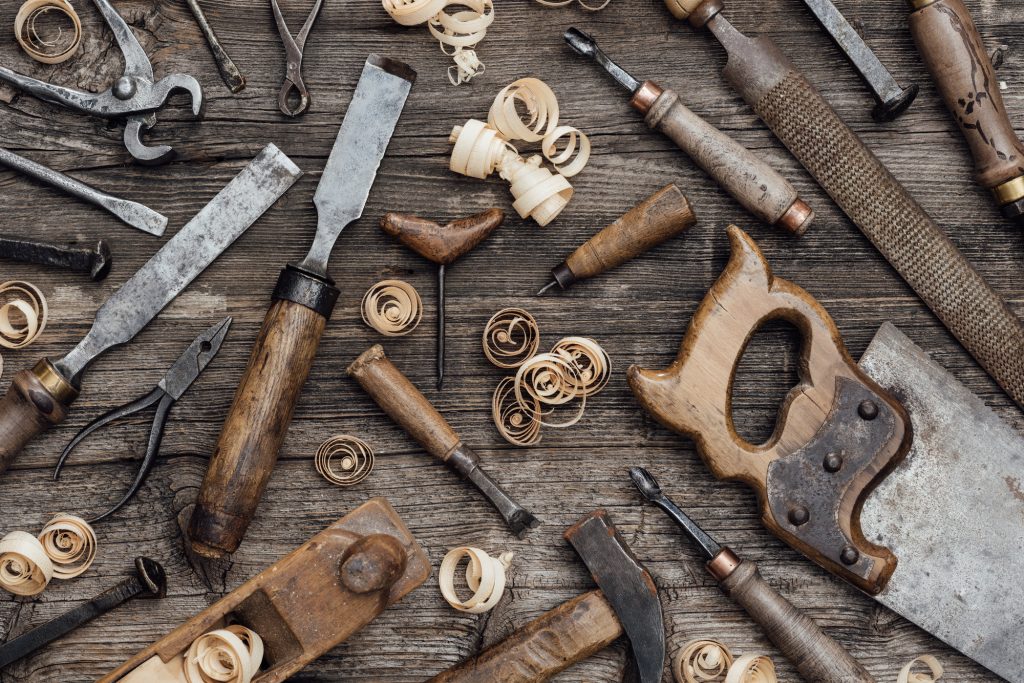Everything You Need for DIY Woodworking Projects
People take on DIY woodworking projects for lots of reasons.
Sometimes, it’s less expensive than hiring someone for the work. Gifts you make often mean more to the recipients. Maybe you just like the challenge of creating something yourself.
You still need the right tools before you start. While the occasional project requires some obscure or highly expensive tool, you can complete most with the tools you’ll find on this list.
So let’s jump in and see what you need.
Safety Equipment
Even very basic DIY wood projects come with some risks. So, before you get down to the woodworking, invest in some essential safety equipment.
First things first, get some safety glasses or goggles. They protect your eyes from flying debris.
Next, get some hearing protection. They typically look like hard plastic earmuffs with foam padding inside.
Finally, buy some kind of breathing protection. Get some paper dust masks at the least. If you plan on making woodworking a hobby, invest in a higher-quality respirator.
Inhaling dust can cause some serious health consequences, such as:
- contact dermatitis
- reduced lung capacity
- asthma
- eczema
- cancer
Core Hand Tools
At the end of the day, you can make almost any DIY woodworking projects using only hand tools. It’s not always easy, but you can do it. Even if you don’t intend on going full hand tool, you should own some core hand tools, including:
- slotted and Philips head screwdrivers
- claw hammer
- sanding block
- crosscut hand saw
- rip cut hand saw
- small block plane
- bar clamps
- chisels
- carpenter’s square
- basic bristle or foam brushes
With only these tools, you can reasonably make a DIY wood table.
Electric Drill/Driver
One of the most useful power tools for DIY wood projects is a basic electric drill/driver.
A drill lets you put in pilot holes for screws that help you avoid splitting the wood. You can take things up a notch and countersink the hole. That drops the head of the screw beneath the surface of the wood.
It also makes short work of driving the screws into place. Many people own two drills. They use one for drilling holes and the second for driving screws.
Take care when you buy drill bits, though, as some are meant for metal.
Circular Saw
Another useful power tool that doesn’t take up a lot of space, the circular saw is a workhorse. Most people use it for making rough sizing cuts in plywood, 2″x4″ lumber, and similar wood.
For long, straight cuts, you can get track systems. The systems can prove expensive, but less costly than a table saw.
Portable Table Saw
For the serious DIY woodworker, a portable table saw will become a necessity. A table saw gives you cleaner cuts in lumber than you can get with a circular saw.
A table saw also opens up or simplifies common woodworking techniques, such as:
- dados
- mortise and tenon joinery
- rabbet joints
- miter cuts
Miter Saw
Miter joints appear in a lot of cool woodworking projects. A good example is the 45-degree angles you often see at the corners of painting frames. You can cut these with nothing but a steady hand and crosscut hand saw.
If you plan on making a lot of miter cuts, you’ll want a miter saw. You can get a miter box, which uses a hand saw and comes in two main types.
A simple miter box is hard plastic and comes with slots for a couple regularly used angles, such as 45 degrees. You can also get an adjustable miter box, which lets you pick your own angle. These work best on trim and other thin pieces of wood.
A good power miter saw typically lets you select an angle and bevel. These work best on larger, thicker pieces of wood.
Router
A router probably isn’t an absolute must-have item for projects like a deck or picnic table. You’ll want one for finer woodworking projects, like desks, tables, or cabinets.
A router lets you change out the bit and put different kinds of decorative edges on a piece. The simplest and one of the most common edges a router puts on is a simple round over. A few other common profiles include:
- roman ogee
- chamfer
- cove
- beading
You can also pair a router up with a guide and use it for dados, rabbets, and dovetails.
Random Orbit Sander
Broadly considered one of the most tedious tasks in woodworking, sanding plays a key role in getting a good finish. Hand sanding and traditional square palm sanders can often leave scratches in your wood. This is especially true with coarser grades of sandpaper.
Random orbit palm sanders go a long way toward solving this problem. They are mostly insensitive to wood grain and leave few discernible scratches.
Saw Horses
A lot of DIY projects happen in less than ideal conditions. For example, you might work out of your garage. Of course, if you must also park in that garage, it leaves very little room for a workbench.
A pair of sawhorses is small, portable, and lets you erect a functional workbench almost anywhere. You just set up the sawhorses on a generally level ground and throw a piece of plywood across them. Instant bench!
Shop Vacuum
Woodworking is a dirty business. Sawing, drilling, and sanding create a lot of fine dust and wood chips. You need an efficient way of cleaning up that mess.
Household vacuum cleaners generally clog up when confronted the fine dust and wood chips you get from woodworking. Shop vacs handle fine dust and wood chips without a problem. It’s their primary function.
You can also use a shop vac as a basic dust collection system. Most power tools now include dust ports. You find inexpensive adapters that let you connect those tools to your shop vac.
It’s not a perfect system, but it will reduce particulates in the air and make post-project cleanup faster.
Parting Thoughts on Tools for DIY Woodworking Projects
Whether you’re taking on DIY woodworking projects for the challenge or more heartfelt gifts, it helps when the right tools are on hand.
The tools above will let you complete most basic and some moderately complicated projects. Looking for a new project now that you have all these tools?
Maybe it’s time for that new deck you want? If so, check out our post on deck building tips.


